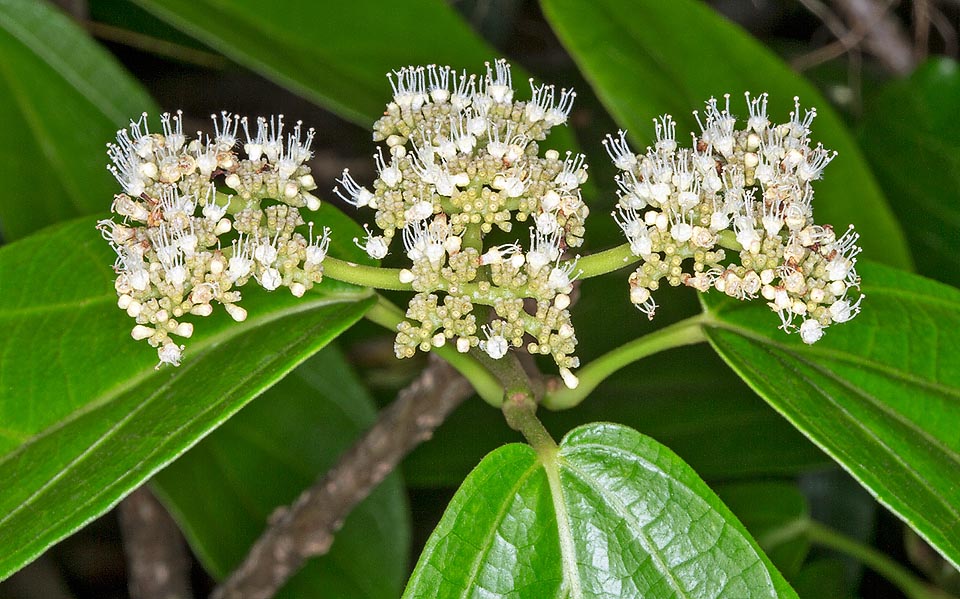Family : Lamiaceae

Text © Pietro Puccio

English translation by Mario Beltramini
The species is native to Andaman Islands, Arunachal Pradesh, Assam, Australia (Queensland), Bangladesh, Bhutan, Borneo, Cambodia, China (Guangdong), Darjeeling, India, Java, Lesser Sunda Islands, Malaysia, Myanmar, Nepal, Nicobar Islands, Philippines, Salomon Islands, Sikkim, Sri Lanka, Sulawesi, Sumatra, Thailand and Vietrnam where it grows in the dry and deciduous forests and thickets, often along the banks of the water streams, up to about 1300 m of altitude.
The name of the genus is the Greek substantive “πρέμνον” (premnon) = stump, with reference to the disorderly posture of the species type; the name of the species is the Latin adjective “tomentosus, a, um” = tomentose, with reference to the down covering various parts of the plant.

Originating from Southeast Asia and Australia, Premna tomentosa can reach 12 m in height with stems 30-50 cm in diameter and dense crown with a messy shrubby bearing © Giuseppe Mazza
The Premna tomentosa Willd. (1800) is a shrub or small deciduous or semi-deciduous tree, up to about 12 m tall and of 30-50 cm of diameter, with rather disorderly and dense crown and brown greyish wrinkly bark.
The leaves, on a 1,5-4 cm long tetragonal petiole coverd by short stellate hairs, are simple, opposite, oblong-ovate with acuminate apex and entire margin, 6-25 cm long and 5-15 cm broad, of intense green colour, glabrous above, pubescent below, aromatic.
Panicle terminal inflorescence, on a 1,5-3,5 cm long pubescent peduncle, formed by corimbose cymes, dichotomically ramified, bearing numerous whitish bisexual flowers.
Campanulate calyx, 2,5 mm long, with five teeth, pubescent, bilabiate corolla, of 5-6 mm of diameter, with rounded upper lip and trilobed lower one, with intermediate lobe retuse and and ovate lateral lobes with obtuse apex, and 4 prominent didynamous stamens (two longer and 2 shorter).
The fruits are globose fleshy drupes, 5-6 mm long and of 3-5 mm of diameter, initially green, then blackish purple when ripe, edible, containing 4 oblong seeds.
It reproduces by seed in draining loam maintained humid at the temperature of 24-26 °C.
Species diffused in a vast area of South-East Asia, where is also cutlivated in limited measure due to its wood, but almost unknown elsewhere, needs a tropical or subtropical climate, an exposition in full sun and draining soils; well rooted requires little care and can stand drought periods.
The leaves are utilized for flavouring the “ghee”, the clarified butter of the Indian cuisine. The wood, of pale brown colour, of average hardness and resistance, is utilized in the construction of the dwellings, for furniture, fixtures, handicrafts and artistic objects and as fuel. Roots, leaves and bark are amply utilized in the traditional medicine, in particular Indian, for various pathologies; laboratory studies have evidenced in the extracts of the plant the presence of compounds with anti-inflammatory and antibacterial activity of possible interest for the official pharmacopoeia.

Terminal paniculate inflorescence, over a pubescent peduncle 1,5-3,5 cm long, composed of corymbose cymes, dichotomously branched, carrying whitish bisexual flowers. The leaves are used to season the "ghee", the clarified butter from Indian cuisine. Roots, leaves and bark show medicinal virtues © Giuseppe Mazza
→ To appreciate the biodiversity within the family LAMIACEAE please click here.
